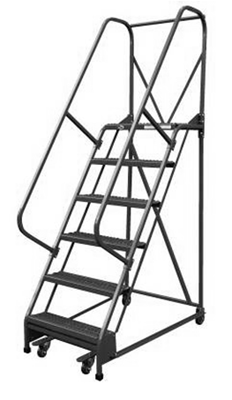 Did you not sign up for the newsletter? It plainly says, working on a ladder of any type can be hazardous to your health! Ladders and step ladders on average account for 14 deaths and over 1000 serious injuries to workers each year. Many of these injuries are caused by improper or faulty use of ladders and associated material handling equipment. The best ladder safety, plan and simple, is common sense.
Did you not sign up for the newsletter? It plainly says, working on a ladder of any type can be hazardous to your health! Ladders and step ladders on average account for 14 deaths and over 1000 serious injuries to workers each year. Many of these injuries are caused by improper or faulty use of ladders and associated material handling equipment. The best ladder safety, plan and simple, is common sense.
First, know when to use a ladder, then decide how to go about selecting the right sort of ladder for the particular job. Experts are convinced that mishandling of ladders at work can be partly explained by the way they are used in the home. As with all work equipment, users need sufficient information and training to be able to use ladders and stepladders safely. It it looks dangerous, it probably is.
When considering whether it could be appropriate to use a ladder or step-ladder, you need to consider the following factors:
Only use a ladder or stepladder in any one position for a maximum of 30 minutes to prevent fatigue or dizziness.
Never use commercial wheel risers to elevate your vehicle or work on a ladder that is not on solid ground. This mean do not put ladders on vehicles to extend your reach. That is the easiest way to get yourself hurt.
Know the weight limitations of your ladder and under no circumstances should you overload a step ladder or ladder from your body weight plus anything they are taking up the ladder.
Never lean over and overreach from the ladder. It is best to keep your belt buckle inside the stiles and both feet on the same rung throughout work being done. Practice safety!
When working on commercial ladders or household stepladders, you should avoid work that imposes a side loading, such as side-on drilling through solid materials (e.g. bricks or concrete), by having the steps facing the work activity. Where side-on loadings cannot be avoided you should prevent the steps from tipping over, for example by tying the steps to a suitable point.
Only use a commercial grade ladder or telescoping extension ladder on firm ground or spread the load on level ground by using a plywood sheet.
Never work on a ladder that is close to overhead power lines, unless the power company or electrician has made them dead or protected with temporary insulation.
When working by a roadway or near vehicular traffic, always use safety cones or barricades to prevent injury. Practice safety!
Never stand on the top rung of a step ladder that does not have handrails or some other means of preventing falls.
It is advisable to not climb or use ladders in strong or gusting winds.
Buying Safe Ladders from Easy Rack.Com
When buying a new commercial or industrial ladder, think about the worst type of surface conditions you might come across (e.g. smooth, wet floor tiles). Manufacturers should be able to Indicate the types of surfaces their products are intended to be used on when they are unsecured (untied). Only buy the commercial or household ladder that suppliers can confirm will be stable enough to be used unsecured in your worse-case scenario, otherwise you will need to take additional measures to secure.
Easy rack offers a wide variety of Industrial & Commercial ladders including Rolling Ladders, Folding Step Ladders, Industrial Ladders, Telescopic Ladders, loading Dock ladders, Commercial Ladders, Steel Ladders and Warehouse Ladders that are key components to any company’s inventory & worker safety. Choosing the right commercial or industrial ladder for your project not only saves on time, but also may save your life. Practice safety!
Contact Easyrack today at 281-342-0200 and we will answer your questions and help you find the right commercial ladder for your needs.
